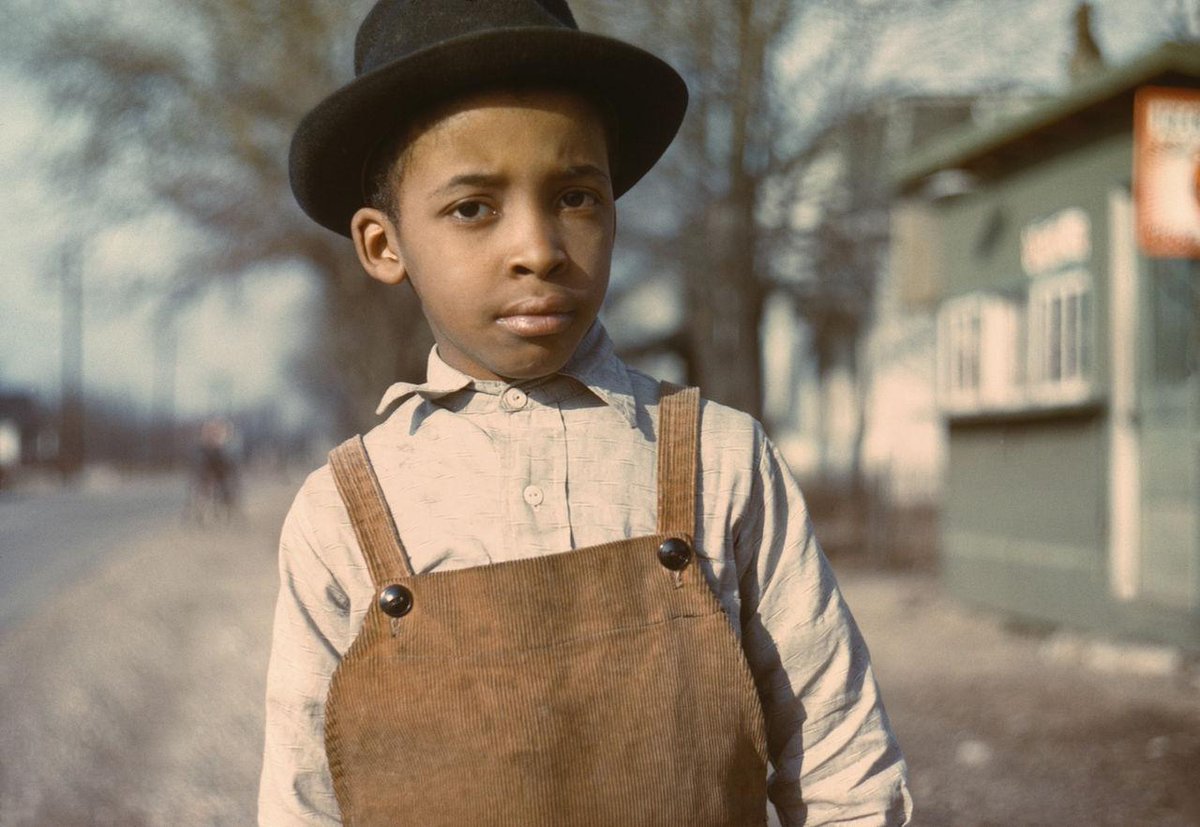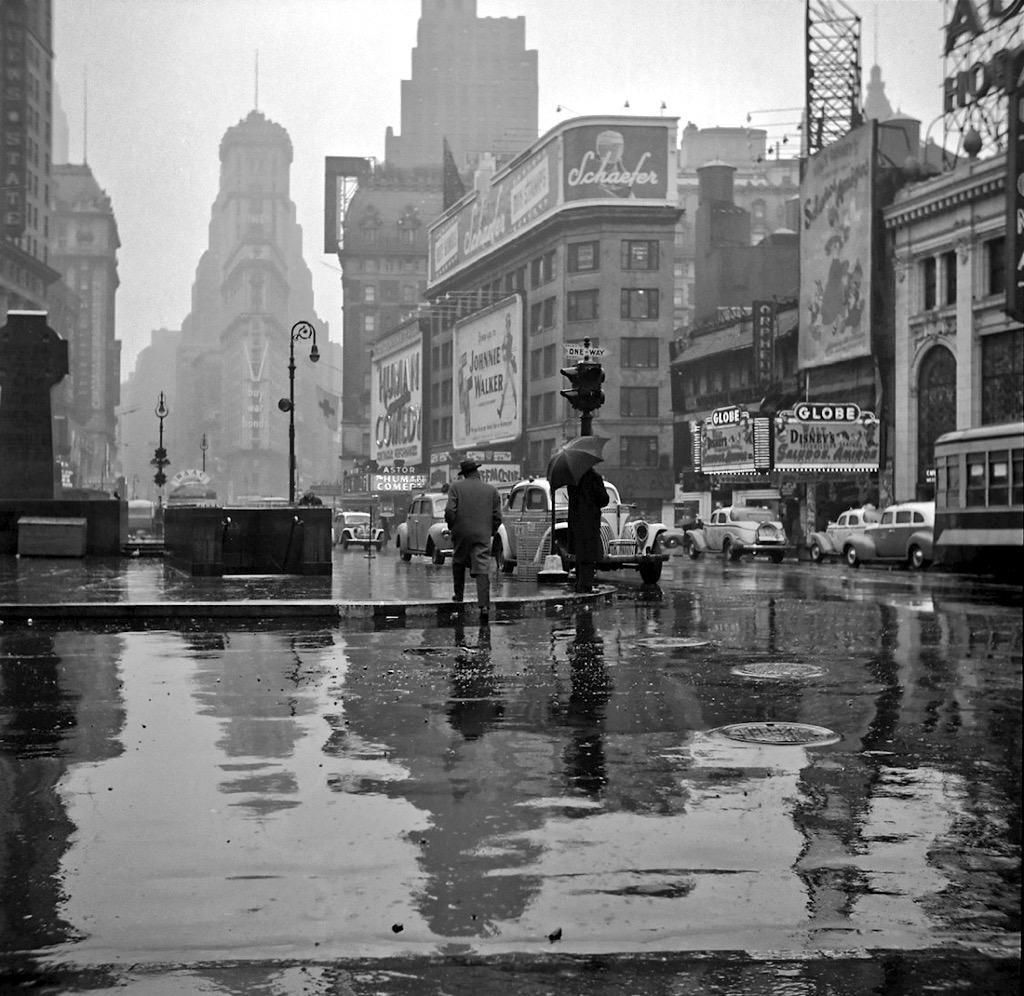.


National Association of Manufacturers signboard, Dubuque, Iowa, April 1940
We live in an old chaos of the sun,
Or old dependency of day and night,
Or island solitude, unsponsored, free,
Of that wide water, inescapable.
Deer walk upon our mountains, and the quail
Whistle about us their spontaneous cries;
Sweet berries ripen in the wilderness;
And, in the isolation of the sky,
At evening, casual flocks of pigeons make
Ambiguous undulations as they sink,
Downward to darkness, on extended wings.
Or old dependency of day and night,
Or island solitude, unsponsored, free,
Of that wide water, inescapable.
Deer walk upon our mountains, and the quail
Whistle about us their spontaneous cries;
Sweet berries ripen in the wilderness;
And, in the isolation of the sky,
At evening, casual flocks of pigeons make
Ambiguous undulations as they sink,
Downward to darkness, on extended wings.
Wallace Stevens: from Sunday Morning (1915) in Harmonium, 1923

Under the El tracks, Chicago, July 1941

Under the El tracks, Chicago, July 1941

Hartford, Wisconsin, Fourth of July, 1941

Chicago, Illinois, July 1941

Chicago, Illinois, July 1941



Chicago, July 1941

Policemen, Chicago, July 1941

[Somewhere in the Upper Midwest], late summer 1941

[Somewhere in the Upper Midwest], late summer 1941

[Somewhere in the Upper Midwest], October 1940

Fargo, North Dakota, October 1940

Dubuque, Iowa, April 1940

Business section, Dubuque, Iowa, with houses of the rich seen on cliffs in background, April 1940

Dubuque, Iowa, gas station at night, April 1940

Boy hopping freight train, Dubuque, Iowa, April 1940

Boy hopping freight train, Dubuque, Iowa, April 1940

Boy hopping freight train, Dubuque, Iowa, April 1940

Man in hobo jungle killing turtle to make soup, Minneapolis, Minnesota, September 1939

Man in hobo jungle, Minneapolis, Minnesota, September 1939

Man in hobo jungle, Minneapolis, Minnesota, September 1939

Unemployed men in Gateway District, Minneapolis, September 1939

Child who lives on the other side of the tracks, Minneapolis, Minnesota, September 1939

Railroad depot, Grand Island, Nebraska, November 1938

Unemployed man, Omaha, Nebraska, November 1938

Farm wife waiting in the car while her husband attends auction, Oskaloosa, Kansas, October 1938

Boys playing with bows and arrows near railroad yards, Dubuque, Iowa, April 1940

Car
belonging to "white spot" enthusiast ("...the white spot of the
nation, no luxury tax, no bonded debt, highways all paid for..."),
Omaha, Nebraska, November 1938

Boy with family belongings in automobile, Yates Center, Kansas, October 1938

Bidding on futures, Minneapolis Grain Exchange, Minneapolis, Minnesota, September 1939

Freight car loaded with sacks of flour, Pillsbury Mills, Minneapolis, Minnesota, September 1939

Migrant woman from Arkansas in roadside camp, Berrien County, Michigan, July 1940

Migrant child from Arkansas in roadside camp, Berrien County, Michigan, July 1940

Liquor store, Omaha, Nebraska, November 1938

Main Street, Yates Center, Kansas, October 1938

Abandoned farm, Nebraska, October 1938

Girl and movie poster, Cincinnati, Ohio: photo by John Vachon, October 1938


Man reading newspaper in Fountain Square, Cincinnati, Ohio: photo by John Vachon, October 1938

Girl watching the sesquicentennial parade, Cincinnati, Ohio: photo by John Vachon, October 1938

Fox chained to automobile, Moorehead, Minnesota, October 1940

Grand Forks, North Dakota: photo by John Vachon, October 1940
Photos by John Vachon (1914-1975) (Farm Security Administration/Office of War Information Collection, Library of Congress)
José Emilio Pacheco: Despedida

#JohnVachon's portrait of a carbon black plant worker is heartbreaking and perfect: image via Carly Piersol @piersolphoto, 23 May 2016
Fracasé. Fue mi culpa. Lo reconozco.
Pero en manera alguna pido perdón o indulgencia:
Eso me pasa por intentar lo imposible.
José Emilio Pacheco (1939-2014): Despedida

Cincinnati, Ohio, 1942. Photo by #JohnVachon: image via Leticia Garcia @Ms_Golightly, 14 June 2015

#JohnVachon: image via Jarry @Jarry1873, 23 November 2015

#JohnVachon - #TimesSquare on a rainy day, #NewYork, 1943: image via Emanuela Morelli @EmanuelaMorell1, 13 October 2015

#JohnVachon Madison Avenue on a rainy day NYC Marzo 1943: image via Cielia Mussari @CieliaMussari, 8 April 2015 Milan, Lombardy




6 comments:
Beautiful post. The past seeming to be right there, ready for us to return to it.
Haunting - the photos and the poems. At least among my Filipino friends, a Despedida is a party wishing someone good luck before they embark on their journey. I'm not suer we ever left. Thanks.
Superb post, Tom. No hay ningún fracaso por aquí.
. . . Downward to darkness, on extended wings. . . .
Thanks for this Tom, Vachon's photos in relation to these lines from Stevens . . . casts light and shadows in both directions (wow).
thanks for those poems Tom...
Volverás a mi huerto y a mi higuera;
por los altos andamios de las flores
pajareará tu alma colmenera
(de Elegía a Ramón Sijé - Miguel Hernández)
Many thanks to all for good words.
Ah, past... are we there? or here?
"...not sure we ever left"
John Vachon's story very closely parallels that of the FSA project in which he learned how to take and love and study and file pictures. He was hired in 1938, a new-in-town kid from Minnesota who knew nothing at all about photography, and, before he had yet learned to take pictures himself, was assigned, as a low-level office clerk, to do captions, keep the files organized... it was this organizing and filing which began and remains to this day largely responsible for the archiving of a magnificent project to which a dozen or more terrific photographers, all of them quite a bit more experienced than JV himself, gave many years of intense work at ridiculous wages... the standard house salary for photographers was $5 a day! ... and perhaps even harder to comprehend from the vantage of now, virtually none of the work was published at the time, the purpose was simply to make and keep an accurate and honest record of how people in America were living, particularly those people in whose lives nobody had ever been interested, because they were, in so many of the places where the photographers went, neither rich nor famous.
And so it is that we do now have this record of how people lived, then, in case anybody should ever wish to look at, and possibly even learn from it.
Post a Comment